 Reversing to the Right
Reversing to the Right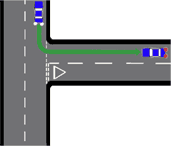
 Reversing to the Right
Reversing to the Right
Reversing to the Right - Introduction
R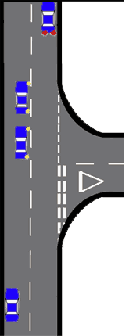 eversing into a side road on the right is a useful manoeuvre when there is no side road on the left to use or on those occasions when you wish to park in a driveway.
eversing into a side road on the right is a useful manoeuvre when there is no side road on the left to use or on those occasions when you wish to park in a driveway.
This tutorial introduces you to the exercise - when you learn and practice how to do it the car you will already be quite well advanced in your training and will probably have some other manoeuvres that require reversing skills.
The manoeuvre starts from a position before the road that we are going to reverse into. You move off and drive past the road we are going to use keeping just to the left of the centre of the road until you are passing the side road (note the timing of the signal). When you reach this position you will need to move over to the right hand kerb.
Then we'll select reverse gear and drive around the corner keeping reasonably close to the kerb, when we're into the new road, straighten up and drive back parallel to the kerb for a distance of about 8 car lengths.
By now you should be familiar with the need to select a Safe, Legal and Convenient place before attempting any manoeuvre. What sort of things should you be considering?
Reverse to the Right - Key Points.
Look all round and make your normal checks before moving off.
Time your signal and move towards the centre of the road.
As you pass the road we're using check for obstructions and the point of turn.
MSM to move to the kerb.
Adjust your seating position and check all round when you prepare to move.
Don't move until you are looking backwards over your left shoulder.
Keep looking as you move to point of turn.
Look all round just before point of turn.
Once you are turning look over the right shoulder - still mainly through the rear window but checking all round.
Half way round the turn hold the lock and wait - keep looking.
Take the lock off just before we come parallel.
In the new road adjust your position and look over the left shoulder.
Drive back about 8 car lengths.
Check all round and use the MSM to move off again.
Reverse to the Right - Summary.
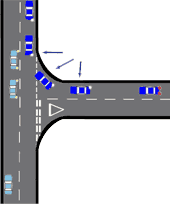 Reversing skills and the manoeuvring exercises are not difficult to master, it just needs practice until you become confident. The key to success is to ensure the vehicle moves slowly enough so that the steering movements will have the greatest effect. You may find it strange at first to find the vehicle responds differently in reverse geasr because you can't feel the car turning with the steering and you have to learn to wait for the steering to take effect.
Reversing skills and the manoeuvring exercises are not difficult to master, it just needs practice until you become confident. The key to success is to ensure the vehicle moves slowly enough so that the steering movements will have the greatest effect. You may find it strange at first to find the vehicle responds differently in reverse geasr because you can't feel the car turning with the steering and you have to learn to wait for the steering to take effect.
When manoeuvring inf a confined area in first or reverse gear we need to maintain close control over the speed. Reversing very slowly enables us to have time for unhurried control over the vehicle and be able to make the necessary checks to the front, side and rear.
We do this by controlling the clutch pedal and using the brake when necessary - would you like a reminder of how to do this?
Once we have learnt how to do the manoeuvre in the car I will ensure you have the opportunity to practice the manoeuvre using corners with varying degrees of difficulty.
Observations.
 Before moving off from a stop position we must make all round observations including - if there were any other traffic or pedestrians coming we'd wait until they were clear before moving off.
Before moving off from a stop position we must make all round observations including - if there were any other traffic or pedestrians coming we'd wait until they were clear before moving off.
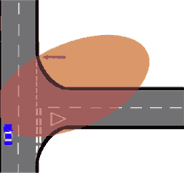 As we move past the road we are going to reverse into we'll need to check for any obstructions or things like children playing which would make it impractical to carry out the manoeuvre. We'll also check the point of turn for the degree of severity as we pass - remember this will affect how much steering will be required and how far we postion ourselves from the kerb before starting.
As we move past the road we are going to reverse into we'll need to check for any obstructions or things like children playing which would make it impractical to carry out the manoeuvre. We'll also check the point of turn for the degree of severity as we pass - remember this will affect how much steering will be required and how far we postion ourselves from the kerb before starting.
Use the MSM move to the right and stop. Don't forget to check all round before preparing to start the manoeuvre.
Can you remember how to adjust your positon when we're preparing to move in reverse?
And what will we looking for when we check all round?
Once we begin reversing we'll be looking mainly over the left shoulder through the rear window but continue to make checks in the nearside mirror to check our position as well as looking for other traffic or pedestrians. Just before the point of turn we'll check all round again - can you remember why?
At the point of turn adjust your position - we need now to be looking mainly through the rear BUT OVER THE RIGHT SHOULDER - this will allow you to keep a better check of how the vehicle is in relation to the kerb - don't forget to keep looking for other traffic and pedestrians.
As we come straight in the new road - again adjust your position so that you're looking mainly to the rear over the left shoulder - still keep checking for other road users.
If we do encounter any traffic or pedestrians we'll wait for them to pass before continuing - once in the new road we would stop and wait for any pedestrians to finish crossing if necessary.
Steering and Accuracy.
As you move to the start position note the severity of the corner - this will affect the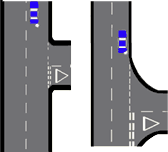 amount of steering that we'll require. Sharper corners will require more steering and we'll need to position ourselves further from the kerb. The normal position is about 2 feet (about the width of a steering wheel) from the kerb.
amount of steering that we'll require. Sharper corners will require more steering and we'll need to position ourselves further from the kerb. The normal position is about 2 feet (about the width of a steering wheel) from the kerb.
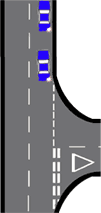
When we begin to reverse we will go back in a straight line until the rear wheels are in line with the point of turn which is the point where we come across the first curved kerbstone, then begin steering round the corner maintaining the same distance from the kerb throughout the exercise.
It will help you to judge your position by remembering the rear wheels are positioned under the rear side windows and using the offside exterior mirror to check on your position.
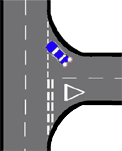
Once we are halfway round the corner, hold the steering lock until we are almost parallel in the new road and then straighten up.
When we are paralel to the kerb in the new road reverse a short distance back - about 8 car lengths and come to a normal stop. We need to drive far enough back to allow us to move off to the correct side of the road and still have time to go through our routine when we emerge from the junction.
Throughout the exercise we'll be making sure that we don't hit the kerb or stray onto the wrong side of the road.
Many people find it difficult to know which way to turn the steering wheel when reversing - try to remember "to steer towards the kerb - turn the wheel towards the kerb and to move away from the kerb turn the wheel away from the kerb".
We'll only be moving slowly when we learn and practice the manoeuvre so the steering movements will be gentle whenever we need to make any adjustments to our position.